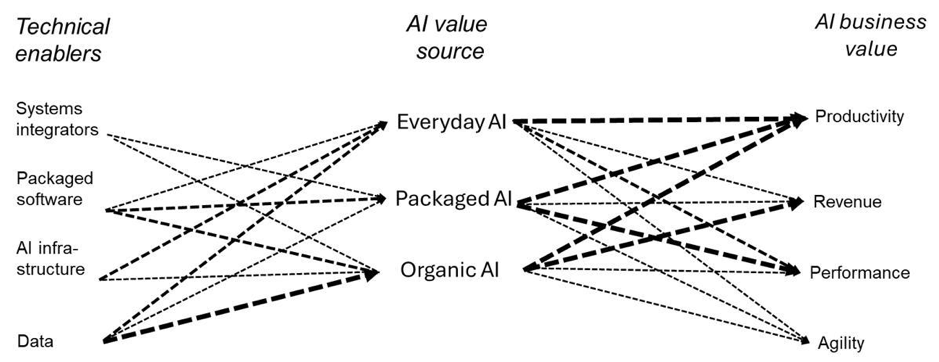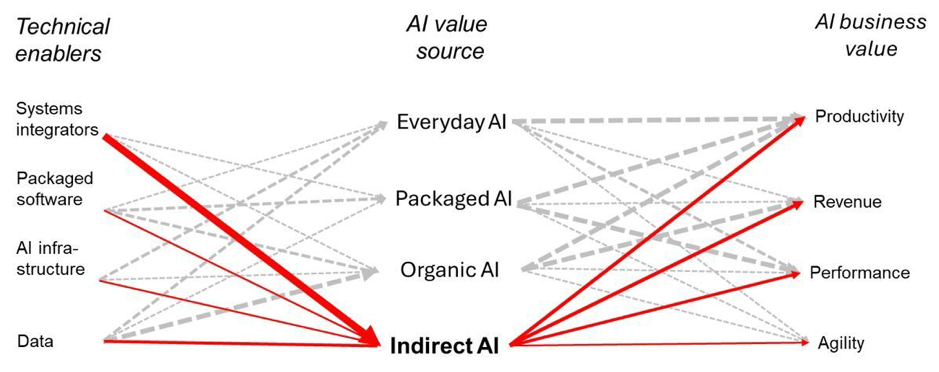The hidden value stream of generative AI
The value of generative AI can go well beyond improved productivity, revenue and business performance – there are also considerable indirect benefits for IT leaders.


However, John Belden, Chief of Strategy and Research at IT Sourcing Advisory Firm UpperEdge, suggests that there is a fourth area of value generation that is often overlooked: indirect AI. This is an additional source of value that can be very significant for businesses (see Figure 2).

Put simply, much of the value of indirect AI comes from the way AI reduces the costs vendors incur when operating their businesses. If most vendors see costs reduced then, at least over time and in an efficient market, the prices they charge for their services should also decrease.
This concept may make some vendors uncomfortable. They might be tempted to say, our costs may have come down, but our quality and speed has increased, so there is no reason for us to reduce our prices. However, putting aside competition as a driver of price in an efficient market, there is a strong reason for vendors to accept lower revenues after they have implemented AI: they are offloading risk to their clients.
Transferring risk
When AI is included in any business process, the outcomes will be uncertain, at least to a degree, especially where machine learning is employed. This is because it is impossible to predict with certainty what decisions an AI system will make. And not all decisions made will be optimal.
Belden warns: “It’s critical to keep in mind that AI tools are not infallible. Even the most advanced AI systems may only be correct 93 percent of the time, meaning that 7 percent of the time, the results could be flawed or misleading. This presents a unique challenge in high-stakes environments where accuracy is critical.” When a client uses a service that includes an element of AI, they are taking on some additional risk. They should be rewarded for this.
The potential savings from using AI should be clear. When vendor organizations employ a new technology to improve their services, they will often refer to themselves as “client one”. By testing the new technology on their own processes, and measuring the savings they make as client one, they can provide evidence to their clients of the savings that they too can make.
These savings are of course a benefit to the client. But, because of the uncertainty of AI-generated outputs, they come with risks attached. There may be unwanted bias resulting in unethical decisions, hallucinations might be generated, or corporate secrets or personal data might be leaked. If clients are to accept these risks, they should also benefit from the savings that the use of AI brings to the vendor. This transfer of risk is therefore significant in a procurement context.
Rethinking project portfolios
There is another feature of indirect AI value that can benefit clients: the ability to rethink priorities in project portfolios.
If an organization is using genAI, costs should be lower. These lowered costs may be relevant to projects that were previously abandoned because they proved to have a weak ROI. But if the costs of these projects are now reduced because of AI, then they may become viable again.
For example, a conversion from SAP ECC to SAP S4 is a project that any SAP user needs to consider. However, these conversions often have a low ROI because they are very expensive. But if genAI can cut the costs by a third, then moving to SAP S4 is much more likely to display an appropriate return. In this case, the SAP conversion project could be reconsidered and given a higher priority than some other potential projects in the portfolio that were previously more attractive.
John Belden at UpperEdge suggests that unlocking previously costly projects is an important advantage of the use of AI by systems integrators. Any significant use of AI by them should therefore prompt a re-evaluation of project portfolios.
Strengthening supplier relationships
Organizations that harvest the value of genAI can use it to strengthen relationships with their suppliers. By evaluating the potential for additional savings over time, they can provide evidence that both parties will benefit from a closer relationship that goes beyond competitive pricing, perhaps one that involves co-innovation, different performance incentives or mutual sustainability initiatives. Companies should choose partners who not only understand the technical aspects of AI but who can also help guide their AI strategy in alignment with their overall business goals.
This additional value can even help a supplier to make a business case for taking on more project work for their clients. Consider software integration: the client organization is often responsible for writing tests scripts and executing testing. But if AI allows the vendor to perform these tasks cost-effectively, then the client can be freed up to focus on other tasks that are more central to its mission, such as selling products or servicing customers.
Value without investment
Generative AI can deliver major benefits to organizations: in productivity, profits and performance. Whether it’s streamlining procurement, enhancing systems integration or improving project management, AI is poised to reshape the business landscape in ways that we’re only beginning to understand. Organizations should prepare for the future while remaining flexible enough to adapt to the ongoing evolution of AI.
As IT suppliers increase their efficiency and drive down their own costs, now is the time for organizations to revisit these relationships and press for those savings to be passed on to them. Organizations will need to re-evaluate all their vendor relationships to consider opportunities for indirect AI value extraction and develop a strategy for successfully navigating this novel issue.
To learn more about how your organization can extract greater value from your suppliers’ use of genAI, visit UpperEdge.

Business Reporter Team
Related Articles
Most Viewed
Winston House, 3rd Floor, Units 306-309, 2-4 Dollis Park, London, N3 1HF
23-29 Hendon Lane, London, N3 1RT
020 8349 4363
© 2025, Lyonsdown Limited. Business Reporter® is a registered trademark of Lyonsdown Ltd. VAT registration number: 830519543





